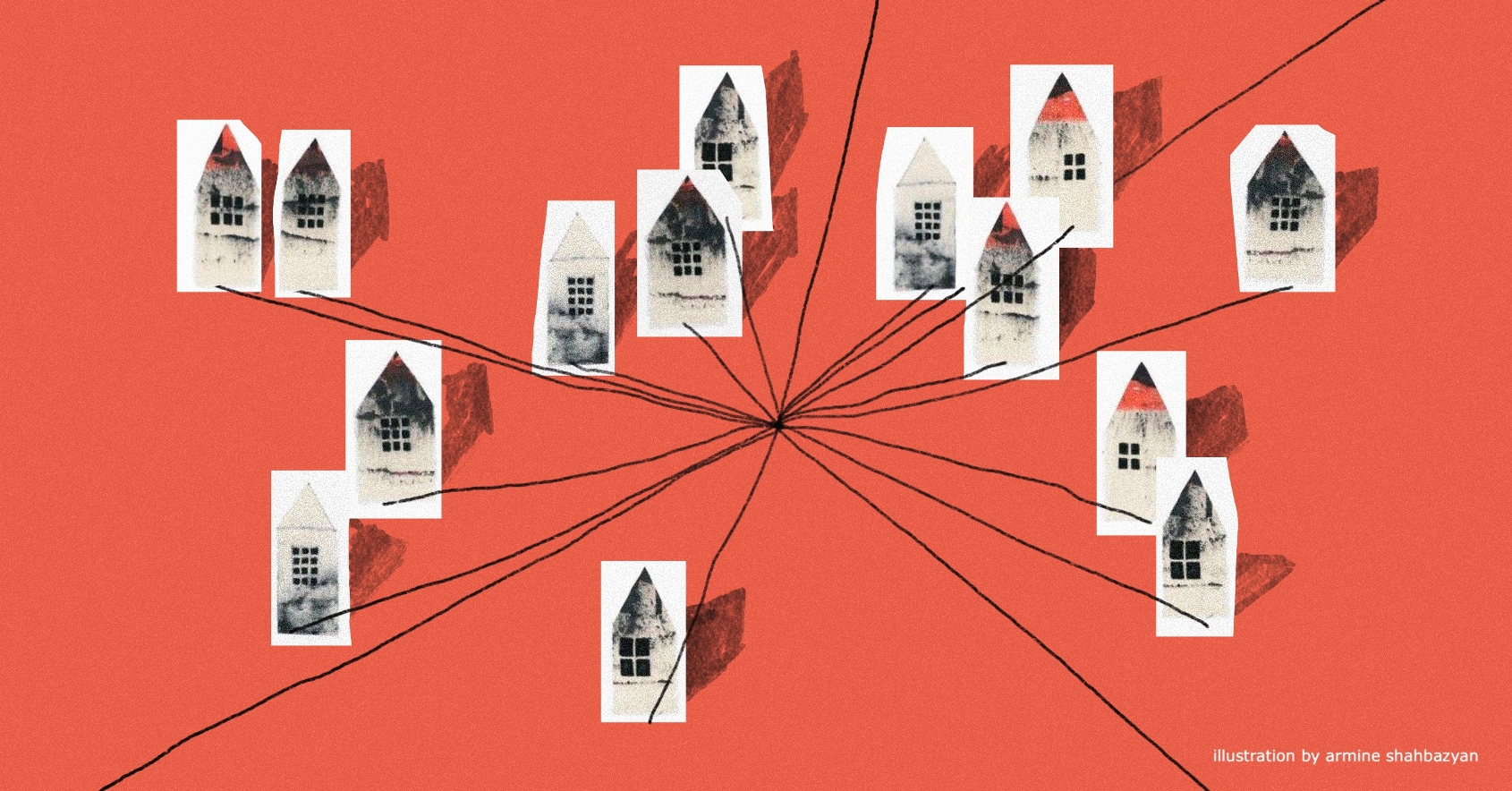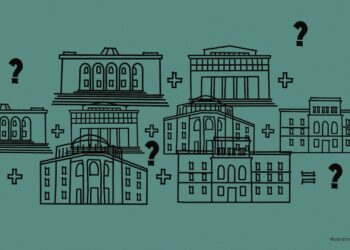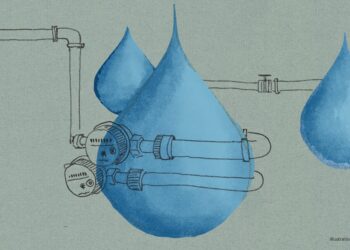
Listen to the article.
New housing construction in Armenia’s border rural settlements has brought vitality and hope to several regions in the country including Tavush, Gegharkunik, Vayots Dzor, Ararat and Syunik. Launched in 2022, the state program allocates 16 million AMD per home to support housing development in border areas. Initially set to end in 2024 with 2,000 homes built, the program’s high demand led to an expansion allowing for 400 additional houses.
From Vision to Reality
Khachik Petrosyan, a resident of the village of Areni in Vayots Dzor, was among the program’s first beneficiaries. He will soon move into his new house with his mother, wife and two children. “We inherited the land in the 1950s, and dreamed of building a house here, but opportunities were limited,” Petrosyan says. “Now, thanks to the state’s support, our dream is coming true.”
Petrosyan encouraged his fellow villagers to apply for the program, resulting in over 100 new homes being built in Areni. Although it was always a border village, Areni, known for its wine-making heritage, was not initially included in state social assistance programs due to its relative prosperity compared to other settlements in similar locations. However, in 2021, the government reassessed its eligibility and included it in the program.
“Each newly constructed house fortifies the border, making the village viable,” he says. “Everyone benefits from this program, the people get a house, the construction workers get jobs, and the community develops.”
Petrosyan says the program’s conditions are simple and attainable: “The bank issues a loan under our name, the state covers both the principal and the interest, so villagers don’t need to pay anything.”
Application Process
From the start, the requirements were kept minimal. Eligible applicants must have land or a partially constructed building in one of the 80 villages throughout Armenia that receive state assistance through a 2014 government decision. They must either choose from the 40 designs offered by the state or have their own approved plan, along with a construction license. To qualify, applicants must be married, with at least one spouse holding Armenian citizenship, and must have no outstanding financial obligations to the state, such as unpaid fines, taxes, or overdue loans. The program does not impose restrictions based on age, number of children, or local registration status.
After submitting the necessary documents to one of six banks and one loan company, a mortgage of 16 million AMD is issued at a 13% interest rate—the current market average. Although banks initially avoided lending to border areas, negotiations between the government and the banks resulted in an agreement.
Funding is disbursed in stages, tied to construction progress. If costs exceed the allocated amount, the applicant is responsible for covering the difference. Since the state covers most of the expenses, many beneficiaries opt to build larger houses. However, the program imposes key conditions: construction must be completed within three years, and the property cannot be sold for ten years. Each family is eligible for support only once. Notably, households can still participate even if they have previously benefited from other state-supported mortgage programs, such as income tax refunds or housing security for families with children.
The program is also available for forcibly displaced people from Artsakh. However, they must choose between this and the housing program specifically offered to them after the ethnic cleansing of Artsakh—they cannot participate in both programs simultaneously.
Yeva Avetisyan’s family is among the 32 families from Artsakh who have benefited from this program. Construction of their two-story house in Sarigyugh village in the Tavush region, is already complete. While they received state funding, they will cover additional expenses themselves, since they decided to use their own design that would give them large windows and a balcony.
“We wouldn’t have had the courage to build a house without this program. The state’s support gave us the confidence to begin constructing our dream house,” Avetisyan says.
A mathematics teacher from Shushi, she now works at Berkaber Secondary School. Her husband serves in the military, and their two sons attend kindergarten. She believes this was the best opportunity to secure her children’s future well-being. When they came across the program online, they “quickly completed the process of obtaining Armenian citizenship” and submitted the bank application. Today, they are impatiently waiting for the day they can move into their new home.
In the program’s first seven months, applications trickled in, leaving the government impatiently awaiting its 100th beneficiary. However, in the second year, interest surged dramatically. The unexpected demand ultimately led to the implementation of a 2,000-house cap on the project.
“At first, people simply didn’t believe that the state would really cover all the costs,” says Vahagn Khudaverdyan, a beneficiary in Berkaber village. “Because of that skepticism, many people missed out on the program. I had already laid the foundations of my house, thanks to the program, when I accidentally overheard someone at the barbershop telling everyone that it was a lie and wasn’t working. I sat in silence until my barber couldn’t take it anymore and pointed at me, saying, ‘This man has already finished half of his construction, how could it be a lie?’”
Khudaverdyan was born and grew up in Berkaber before moving to Ijevan. “I always wanted to have my own house in my village,” he says. “Without the state’s support, my dream of building a home would have remained just that, a dream. It is challenging, but watching it transform from blueprint to reality is very satisfying. ”
Expansion
Construction of 100 houses is underway in Berkaber, which will double the number of homes in the village. This overwhelming response prompted the government to reopen the program in 2024 with modifications. The revised program now accepts 40 applications each for Berkaber and Kirants communities in Tavush region, and 50 applications each from Baghanis and Voskepar. Notably, applicants from these communities will receive an additional five million drams if they have been registered there for at least one year when applying.
Those who received construction permits before September 1, 2024, remain eligible for the program.
The program’s expansion launched with a modification, starting in Gomk village in Vayots Dzor. Although Gomk, with its 144 residents, is not a borderline village, a school for 100 students was built there in 2024. Currently, the school has 25 students. Prime Minister Nikol Pashinyan designated Gomk as the starting point for the program’s second stage, solidifying the initiative and supporting community development. The village has been allocated 30 houses, with five reserved for teachers. Additionally, having a child under 13 has become a mandatory requirement.
As of February 2025, 2,209 families have been approved as beneficiaries of the program across different regions: 1,444 in Tavush, 225 in Syunik, 284 in Vayots Dzor, 146 in Ararat, and 110 in Gegharkunik. Seventy houses are complete and have been issued deeds.
This program, according to Minister of Labor and Social Affairs Narek Mkrtchyan, is one of their success stories.
Continuity
In border villages, the beneficiaries of the program were mostly those who had moved out of extended families, young families living in rentals, and people who had emigrated due to lack of housing. Through this program, they now have the opportunity to return and live in their homeland. Notably, more than 90% of the beneficiaries are local community members, though the government welcomes newcomers as well.
Davit Khachatryan, Deputy Minister of Labor and Social Affairs says the program serves multiple purposes: “It’s not just about building new homes—it’s about revitalizing villages and attracting new residents, even temporarily. This, in turn, boosts property tax revenue, stimulates local trade, and strengthens municipal budgets, making the program a catalyst for sustainable community growth.”
Khachatryan explained that the program’s continuation and potential expansion to other settlements will depend on financial feasibility, economic impact and overall effectiveness. While acknowledging that some beneficiaries may experience challenges in completing construction, he emphasized that the program would still be considered a success if the vast majority benefit from stable housing.
The boom in construction has driven up both land demand and property values in participating communities. Khachatryan sees this as a positive development, an indicator of growing confidence in rural real estate. Beyond providing housing security, the program is seen as a driver of broader community development, with the potential to scale up and include more settlements in the future.
Law & Society
Anatomy of a Process: Yerevan Transportation Reform
Yerevan's ongoing transportation reform, launched in 2017, highlights the lack of strategic planning, leadership and accountability. Without a comprehensive approach, clear oversight and implementation, any reform process will not fulfill its intended goal: to benefit the public.
Read moreReservoirs: Key to Armenia’s Water Security Amid Climate Change
Armenia faces mounting water security challenges as climate change intensifies floods and droughts. Reservoirs can play a pivotal role in managing these risks, ensuring water availability and supporting sustainable development through improved storage, infrastructure, and strategic planning initiatives. Hranoush Dermoyan explains.
Read moreMotherhood Behind Bars
Exploring the lives of incarcerated mothers at Armenia's Abovyan Penitentiary, Astghik Karapetyan delves into the challenges of raising children in confinement, the impact on maternal bonds, and the institutional efforts to balance rehabilitation with the children’s best interests.
Read moreNew Law on Higher Education: Meaningful Reform or Top-Down Policy?
A new Draft Law on Higher Education and Science has ignited public debate in Armenia. While introducing necessary reforms, experts fear certain amendments could threaten the core principles of the higher education system, including academic autonomy, regional equity and free competition.
Read moreAbundance of Both Water and Mismanagement
Armenia faces growing challenges in managing its water resources. Lake Sevan, a crucial water source, is being overused for irrigation, raising concerns about long-term sustainability. Mariam Tashchyan explores the factors behind Armenia’s water crisis.
Read more






Excellent program, how can we contribute?